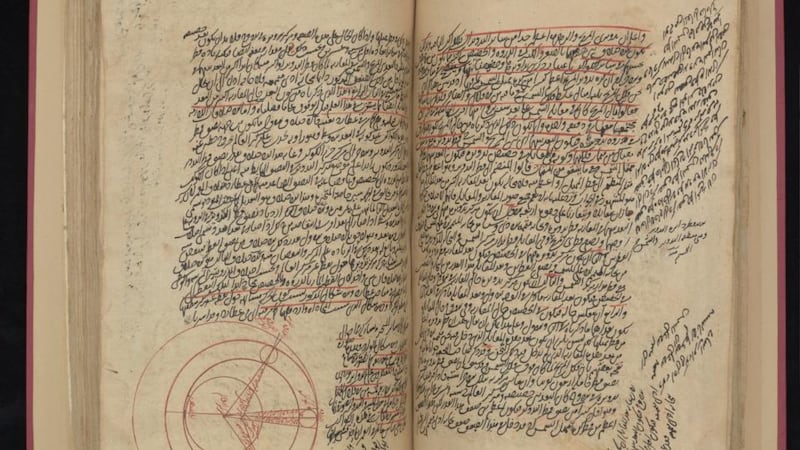Many western Europeans tend to assume that rigorous, structured science only arose in the 17th century in the Age of Enlightenment. However, sophisticated studies of mathematics, astronomy and medicine were being conducted centuries earlier in the Middle East.
Scholars were writing medical textbooks explaining circulation and the nervous system. Astronomy books were interpreting the movements of the planets and moon. Maths as we know it was taking shape. Many texts were written from the 12th century, and based on even earlier work, long before the age of reason took hold across western Europe.
It might also surprise some that one of the finest collections of these beautiful manuscripts is held in Ireland: at the Chester Beatty Library in Dublin, where a number of these priceless works are on display. These reveal that scholarly work in astronomy and medical science was well-established and that a support system, often through the patronage of wealthy families, was sustaining this work at a significant level, says Fionnuala Croke, the director of the library.

How this began is exemplified by the Islamic contribution to the study of maths. Many of the brilliant new conceptions attributed to European mathematicians of the 16th, 17th and 18th centuries actually emerged much earlier in Baghdad, in about AD 800, she says. “Without the Muslim achievements at this time, much of the learning from ancient Greece, Rome and Egypt would have been lost forever.”
It began under the Caliph Harun al-Rashid of the Abbasid dynasty, who assumed power in AD 786. He encouraged scholarship and the translation of original Greek documents into Arabic, says Croke. His son continued this work with even more enthusiasm, setting up the House of Wisdom in Baghdad, which Croke describes as "a kind of medieval think tank".
Euclid's
Elements
Among the Greek texts translated was one of the most famous mathematical texts of all time: Euclid's
Elements
. Its translation allowed for its study and development by Islamic scholars.
Beatty's manuscript collection includes a translation of Elements by Ishaq ibn Hunayn, completed during the later half of the 10th century. This, and another text by Thabit Ibn Qurra, became a standard, used by 50 further Arabic scholars who revised and wrote commentaries on it.
Many scholars developed mathematical and astronomical knowledge over the following centuries, and many are represented in the library's collection. It has several copies of Nasir al-Din al-Tusi's Elements . He was a leading mathematician, and one of the first to treat trigonometry as a separate mathematical discipline, but he was also an astronomer and was put in charge of an observatory at Maragheh, Iran. He produced a catalogue of fixed stars that remained in use for several centuries, from China to western Europe, says Croke.
A commentary on al-Tusi’s work by Mansur ibn Ilyas, writing in Iran in 1430, is on display at the library. It shows how later scholars wrote in the margins of books, adding new knowledge as it arose.
Also on display is Tashrih al-Badan , a treatise on human anatomy by Mansur ibn Ilyas, writing in Iran in 1450. Others on display include a copy of a treatise on surgery by al-Zahrawi, who died in 1013. His work would have been copied by others: the version at the library dates from the 13th century.
It is perhaps more by accident than design that such a remarkable collection came to be in Ireland. “It was the personal collection of Sir Alfred Chester Beatty. He was born in New York city in 1875,” says Croke. He became a millionaire mining expert, but his other passion was collecting. The 30,000 items held by the library were acquired over a working lifetime, and, when he moved from the US to the UK in 1912, his attention was turned to rare manuscripts from Europe, the Middle East, Far East and north Africa. “Quality and rarity were the two bywords. He relied on expert advice from dealers, but he did have an eye,” says Croke.
He became frustrated with the politics of Britain after the second World War, however, and he decided, aged 75, to move home and library to Dublin. Shrewsbury Avenue provided a home for his collection until it was moved to the rear of Dublin Castle in 2000.
The government of the day was delighted to help him, given the astounding value and importance of the library. He was afforded a state funeral when he died in 1968, the only civilian non-politician to receive such an honour.
CHESTER BEATTY COLLECTION: 'ONE OF IRELAND'S GREATEST GIFTS'
The Chester Beatty manuscript collection is "one of the greatest gifts ever given to Ireland", says Chester Beatty Library's director, Fionnuala Croke.
It includes some of the earliest-known copies of the Gospels and Acts of the Apostles, including Letters of St Paul to the Corinthians, written in Greek. It also holds one of the world’s oldest printed documents, a Japanese Buddhist charm or prayer printed on paper in AD 764, long before Gutenberg developed the printing press in the 1400s. It includes material dating from 2700 BC up to the present, and much of it is priceless. There are manuscripts from Asia, north Africa, Europe and the Middle East.
The Islamic and Arabic elements of the collection provide many very fine examples of scientific works covering areas such as astronomy, medicine and medical surgery. Europe was struggling through the Middle Ages, but the study of maths, astronomy and medicine was flourishing in the Middle East at the time.
Calligraphy was important in the Islamic world, and these handwritten manuscripts from the 8th, 9th and 10th centuries show the work of some of the time’s leading practitioners. The scientists working on the manuscripts were often also the calligraphers, but the documents were not treated as completed books. They were frequently heavily annotated, with later discoveries added in to keep the work up-to-date.
“These were working documents that passed from scholar to student to scholar,” says Derval O’Carroll, Chester Beatty Library’s head of operations.

